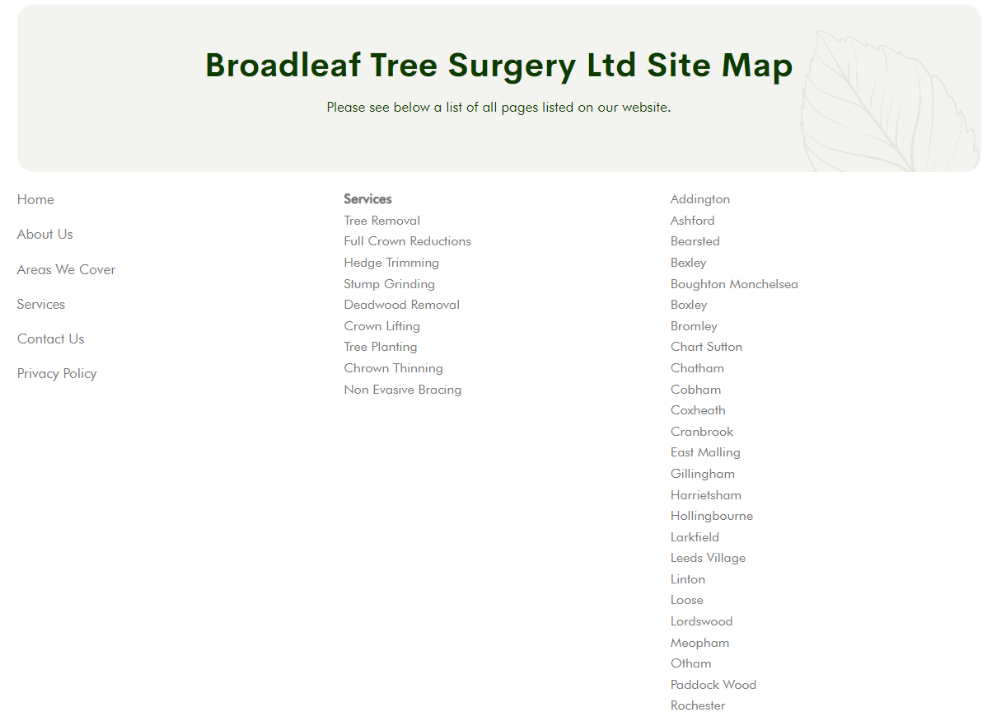If you’re here, you’re probably already aware that sitemaps can make a massive difference to a website’s visibility in search engines. But because of the technical nature of the topic, it might often be intimidating to know where to start from. Don’t worry though, we’re here to answer all of your burning questions and demystify the topic. But first, what is actually a sitemap?
A sitemap is a blueprint of your website that’s there to simplify Google’s job of crawling your website. It includes a list of all of the pages and files on your website that you consider important and key information about those assets.
Read on to find out what a sitemap looks like and how to create one for your website. We also look at how search engines use sitemaps and the benefits of having a sitemap for SEO.
When you visit a new city, you might find yourself opening a map of it and finding the places you want to visit to help you get around. Of course, you can always ask people for directions and while this often does the job, it can take longer or get confusing.
The same thing applies when Google visits your website; if there is a map of your online place, then Google wouldn’t have to waste time asking for directions and instead, can just get straight to the desired spot – the page you want to rank!
A sitemap is essentially a page/file that shows all pages on your website. Within the sitemap, you can also add any additional files you have; e.g. videos, images, etc.
By adding a sitemap to your website, you’re helping search engines better understand the structure of your website and hence, find your pages quicker.
There are two main types of sitemaps: XML sitemaps and HTML sitemaps.
An XML sitemap is created solely to help search engines understand your website better. For example, this is our website’s sitemap. It features all key pages on the Wildcat Digital website, the date that those pages were last modified, and the number of images each page has.
Wildcat tip: once you have the XML sitemap of your website, submit it to Google Search Console and Bing Webmaster Tools, plus any other search engines your target audience uses. This will make a massive difference to the speed at which search engines discover new and existing pages.
While XML sitemaps are solely created for search engines, HTML sitemaps are there to facilitate your website visitors’ journey.
An HTML sitemap, also known as a human-readable sitemap, usually takes the form of a single page that lists every single page of your website. You might think that’s too simple, but it’s exactly what’s needed to help users have a quick look and find what they’re after.
You’d usually link to the HTML sitemap in your website’s footer.
And here’s something handy: to make the HTML sitemap more user-friendly, you can split the pages into different categories. For example, start with your top-level pages (homepage, categories, etc), and then list Product Categories, then Products, etc. Of course, make it tailored to your website. Simply ask yourself the question ‘What would be the easiest way for me to find a page in the sitemap?’ and then you’ll find what’s the best way to structure it.
The benefit of an HTML sitemap is clear: you’re making sure website visitors can navigate through your website quicker in case they’re looking for something specific. Human-readable sitemaps can also improve internal linking.
An XML sitemap can take multiple forms, but it’s usually either a single page with all URLs of a website listed on it, or a page with multiple sitemaps within it.
For example, the XML sitemap of our website has all of our pages, grouped into 6 individual categories (sitemaps): a sitemap with all blogs, a sitemap with all current job adverts, a sitemap with all categories, etc. We’ve done it in this way so that it’s easier for search engines to understand our website’s architecture and connection between the different pages.

An HTML sitemap can take multiple forms depending on how you create it. For example, below you can see Broadleaf Tree Surgery’s human-readable sitemap. It has all key pages on the left, all service pages in the middle, and all location pages on the right-hand side.

There’s no one way of creating a sitemap. Our top advice here is to use a plugin, which will automatically add new pages or remove any deleted/redirected pages. This will save you tons of time and ensure your sitemap is up to date.
To create an XML sitemap, we recommend using the Yoast SEO plugin if you’re using WordPress. It’s super easy to set up and the plugin takes care of everything: updating the sitemap with new pages, creating dedicated sitemaps for the different types of pages, etc. Follow this step-by-step guide and start seeing the results.
If you’re using WordPress, but for some reason you can’t or you don’t want to use a plugin, then you can create a dynamic sitemap in PHP. This requires having technical website knowledge, so ask your website’s Developer for help.
Using Shopify? You’ll be pleased to know that Shopify automatically creates a sitemap for your website. Simply type your homepage URL and then add /sitemap.xml to it; that’s your sitemap! If you run into any issues, check out Shopify’s advice for sitemaps.
Reminder: once you’ve generated your XML sitemap, remember to submit it to Google Search Console and other engines.
When it comes to human-readable sitemaps, again there are multiple plugins that can help you generate this. Once again, even if it seems tempting to just create the page manually, it’s best to use a plugin or create it in PHP so that you don’t need to worry about updating it manually.
The WP Sitemap Page and Simple Sitemap plugins are two of our favourites for generating an HTML sitemap.
On Shopify, it’s slightly trickier as you need to fiddle around with the code. Ask your Web Developer or get in touch if you need help with this and all things SEO.
Finally, don’t forget to add a link to your sitemap in the footer.
Your XML sitemap is the first thing Google sees when it arrives on your website. Once Google and other search engines ‘visit’ your sitemap, they see the URLs on your website and from there, they start crawling and indexing them.
You might think ‘Surely, search engines don’t need the sitemap; they can just use the navigation and internal links to find the pages they need to crawl’. Yes, but what if you have thousands of pages or have pages which are not linked to from other pages?
That’s where having a sitemap comes in handy. It makes it easier for Googlebot and other search engine bots to discover new/existing pages and understand your content.
If you’re ready to take your website to the next level, get in touch. We can create an XML and an HTML sitemap for you, while also ensuring there are no other technical issues on your website that might be impacting your website’s visibility.
Have a look at Google’s official documentation for more best practices
Google suggests that if your website is under 500 pages, you don’t necessarily need a sitemap. However, considering that creating a sitemap and submitting it can take less than 30 minutes, it can be beneficial to have it from the get-go.
Simply submit your sitemap to Google Search Console and Google should discover it within 48 hours. You can see when Google’s last read it and how many URLs it has discovered.
If you run into any errors, make sure to check Search Console Help for further advice.

Founder
Our founder, Will Hitchmough, worked at a number of high profile Sheffield Digital Agencies before founding Wildcat Digital in 2018. He brings an extensive knowledge of all things related to SEO, PPC and Paid Social, as well as an expert knowledge of digital strategy.
Digital Marketing can be a minefield for many businesses, with many agencies ready to take your money without knowing how to deliver results. I founded Wildcat Digital to deliver digital success to businesses with smaller budgets in a transparent way.

Head of Growth
Rich joined us in May 2024 to head up our growth team. With years of experience helping other agencies to grow, Rich joins us at an exciting time as Wildcat is working on a five-year plan to become one of the biggest agencies in the UK.
Outside of work, Rich is a father to three children, which keeps him very busy! He’s also recently started running again to keep fit and loves a bit of DIY.

Head of Digital
Sarah joined Wildcat in January 2025, bringing over seven years of SEO expertise to the team. With a background in Fashion Communication and Promotion, she has worked both in-house and at agencies, covering a range of digital marketing specialisms before focusing on SEO.
Passionate about all things search, Sarah thrives on helping brands grow their online presence.
Outside of work, she enjoys walking her dog, running, and shopping for vintage clothing.

Office Manager
Amelia joined Wildcat Digital in January 2025, bringing extensive experience in HR, Health & Safety, Facilities Management and IT Support. Previously an Operations Manager at The University of Sheffield, she has a strong background in creating efficient and well-organized work environments.
Specialising in HR, Health & Safety, and Facilities Management, Amelia ensures the Wildcat Digital team has the resources and support needed to thrive. Whether managing office operations, maintaining compliance, or fostering a positive workplace culture, she keeps everything running smoothly.
Outside of work, Amelia loves trying new things, traveling, camping, and walking. She also enjoys socialising and exploring new places with friends and family. Her adventurous spirit and proactive approach make her a valued member of the team.

Client Success Coordinator
Siena joined us in 2023 with a background in sales and digital marketing. She leads on client relationships across the company, ensuring that our customers are happy throughout their journey with us, from their initial consultation through to onboarding and beyond.
Outside of work, Siena enjoys travelling and getting stuck into the local culture. She likes to make the most of her experiences and particularly enjoys watching sunrises and sunsets from beautiful locations around the world.

SEO Account Director
Paul has a strong background in SEO, having previously founded and ran a successful eCommerce business, as well as running a personal blog that achieves an average of 17K users per month. Paul’s knowledge of SEO is extensive, with a strong emphasis on client handling and technical SEO.
Outside of work, Paul enjoys spending time with his family and staying active with weight lifting and combat sports.

Team Lead & Technical SEO Account Manager
With a degree in Computer Science and SEO experience dating back to 2017, Dariusz has a wide range of SEO skills and knowledge. His specialist knowledge of Technical SEO has firmly landed him the title of Wildcat’s Technical Wizard, and he has recently taken on the responsibility of Team Leader for the Panthers Team.
In his spare time, Dariusz loves hiking, experimenting and trying new coffees and loves learning new things. He is currently learning more about CRO and AI and how this could benefit our clients.

Team Lead & Senior SEO Account Manager
With a background in sales, Molly is a natural Account Manager, brilliantly handling any issues that come her way. Having joined us as a Digital Marketing Executive, and working part-time through her final year of University, Molly is a shining example of how hard work pays off. She is now an SEO Account Manager with a particular interest in Content and Client Management.
In her spare time, Molly loves to get out in nature, hiking and exploring the Peak District. She also loves cooking and likes to unwind with a bit of yoga.

PPC Team Leader
Libby joined Wildcat in 2021 as our first PPC hire. With a degree in Digital Media Production, a Master’s in Digital Media Management and previous experience in Social Media Management, Libby hit the ground running and has since climbed the ranks to Senior PPC Account Manager and has a particular interest in the eCommerce sector.
Outside of work, Libby likes gaming, and cooking and likes to keep active by lifting weights.

Senior SEO Account Manager
With a degree in Film and TV production, and a varied career history, Jamie made the move to marketing with a Masters degree in Digital Media Management. He has since worked in SEO at Agencies across Sheffield, before joining Wildcat and working his way up to SEO Account Manager. Jamie has a particular interest in backlinks and Digital PR and has recently gained a client a valuable backlink from Forbes!
In his spare time, Jamie is an avid foodie and loves trying new restaurants and cuisines. He also loves to travel and spent a year travelling to Australia after university.

SEO Account Manager
Jasmine joined Wildcat in 2022 with a strong background in SEO and Account Management. At the time, she was finishing up a Level 4 Apprenticeship in Digital Marketing from the Chartered Institute of Marketing, and has since worked her way up to SEO Account Manager. Jasmine excels at content writing and promotion, and particularly enjoys finding creative ways to join the dots on multi-channel campaigns.
In her spare time, Jasmine volunteers at a charity, helping combat loneliness & social isolation experienced by older neighbours. Outside of Wildcat, she owns a catering company, Savery Grazing, creating delicious grazing tables & platters for a range of events. She also loves skiing and exploring the Peak District.

SEO Account Manager
Thea has a wealth of experience in SEO, having previously worked for other Digital Marketing Agencies in Sheffield. She has a particular interest and skills in Technical SEO, but is more than willing to get stuck in and give anything a go.
Outside of work, Thea spends most of her time with her children, but also loves reading, photography and gardening.

PPC Account Manager
Masilda joined the Wildcat team in October 2024 with over seven years of experience in digital marketing. She specialises in Google Ads, but is also certified in Google Analytics, YouTube Ads, Google Ads for Ecommerce and Apple Search Ads. She has extensive expertise in performance marketing, display advertising, online lead generation and market planning.
In her free time, Masilda likes staying active, cooking, trying new restaurants and exploring new places.

Senior SEO Executive
After spending ten years managing businesses, restaurants, cafes and event spaces across Sheffield, Jon decided to change careers and joined Wildcat as an SEO Executive in 2022. He especially enjoys the client management side of the job, helping them to understand digital marketing and ways in which they can build their business’s presence online.
Outside of work, Jon likes to keep fit with running, badminton and football, and also loves music.

Senior SEO Executive
Andy joined Wildcat in 2023 after starting his digital marketing career in-house for a local Sheffield company. Since joining, he has developed a strong interest in Technical SEO and has strong skills in Account Management.
Outside of work, Andy loves music and plays in a couple of bands. He also enjoys rock climbing, cycling, photography and good food.

Senior SEO Executive
Kezia joined us in July 2024 after completing a CIM Certificate in Digital Marketing and gaining experience in Content SEO at another Sheffield agency.
In her spare time, Kezia loves to get outdoors, bouldering, hiking and travelling.

Senior PPC Executive
Alex joined Wildcat Digital in December 2024 as a Senior PPC Executive, bringing a strong background in Paid Media, Paid Social, and Programmatic advertising. With a degree in Business & Marketing and Google Ads certifications, she has the expertise to craft high-performing campaigns that drive results.
Before joining Wildcat Digital, Alex worked at two leading agencies in Leeds, honing her skills across various digital advertising platforms. Her analytical mindset and strategic approach help businesses maximize their online presence and advertising budgets.
Outside of work, Alex enjoys spending time with her dog, Lola, and going on walks with her dog walking group. She’s also a keen footballer and loves playing five-a-side whenever she gets the chance. Her enthusiasm and team spirit make him a great addition to the Wildcat Digital team.

SEO Executive
Amy joined Wildcat in 2024 with a background in journalism, having worked as a News Editor and Editor-in-Chief at The Sheffield Tab. She is naturally interested in Content SEO and research, so will no doubt prove to be a content power-house.
In her spare time, Amy loves watching crime shows, listening to music and hanging out with her dog, Eddie!

June 30, 2025
Welcome to June’s digital marketing news roundup. There’s been major changes in both PPC and SEO, especially regarding AI. We’ll…
May 30, 2025
If you’ve ever tried searching for a local business or service, the chances are you’ve come across a Google map…

May 20, 2025
Welcome to this month’s digital marketing news roundup! As ever the digital landscape continues to transform at lightning speed, so…